engine Citroen C3 2017 2.G Owner's Manual
[x] Cancel search | Manufacturer: CITROEN, Model Year: 2017, Model line: C3, Model: Citroen C3 2017 2.GPages: 450, PDF Size: 10.11 MB
Page 5 of 450
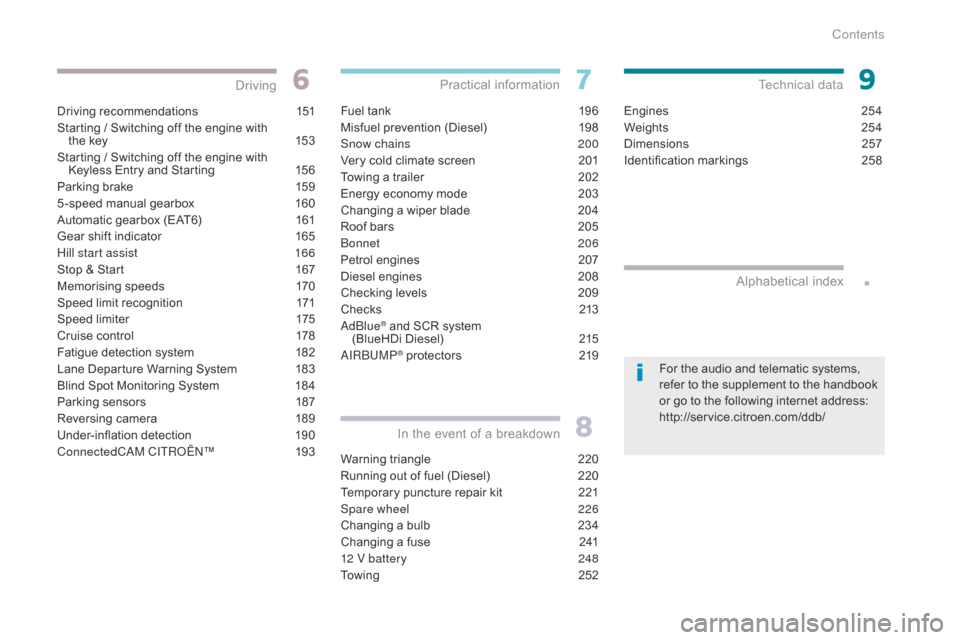
.
B618_en_Chap00a_sommaire_ed01-2016
Driving recommendations 151
Starting / Switching off the engine with the key
1
53
Starting / Switching off the engine with Keyless Entry and Starting
1
56
Parking brake
1
59
5 -speed manual gearbox
1
60
Automatic gearbox (EAT6)
1
61
Gear shift indicator
1
65
Hill start assist
1
66
Stop & Start
1
67
Memorising speeds
1
70
Speed limit recognition
1
71
Speed limiter
1
75
Cruise control
1
78
Fatigue detection system
1
82
Lane Departure Warning System
1
83
Blind Spot Monitoring System
1
84
Parking sensors
1
87
Reversing camera
1
89
Under-inflation detection
1
90
ConnectedCAM C
ITROËN
™ 19
3
Driving
Fuel tank 196
Misfuel prevention (Diesel)
1
98
Snow chains
2
00
Very cold climate screen
2
01
Towing a trailer
2
02
Energy economy mode
2
03
Changing a wiper blade
2
04
Roof bars
2
05
Bonnet
206
Petrol engines
2
07
Diesel engines
2
08
Checking levels
2
09
Chec ks
2
13
AdBlue
® and SCR system
(BlueHDi Diesel) 2 15
AIRBUMP
® protectors 2 19
Practical information
Warning triangle 2 20
Running out of fuel (Diesel)
2
20
Temporary puncture repair kit
2
21
Spare wheel
2
26
Changing a bulb
2
34
Changing a fuse
2
41
12 V battery
2
48
To w i n g
2
5 2
In the event of a breakdown
Engines 254
Weights
2
54
Dimensions
2
57
Identification markings
2
58
Technical data
Alphabetical index
For the audio and telematic systems,
refer to the supplement to the handbook
or go to the following internet address:
http://service.citroen.com/ddb/
Contents
Page 6 of 450
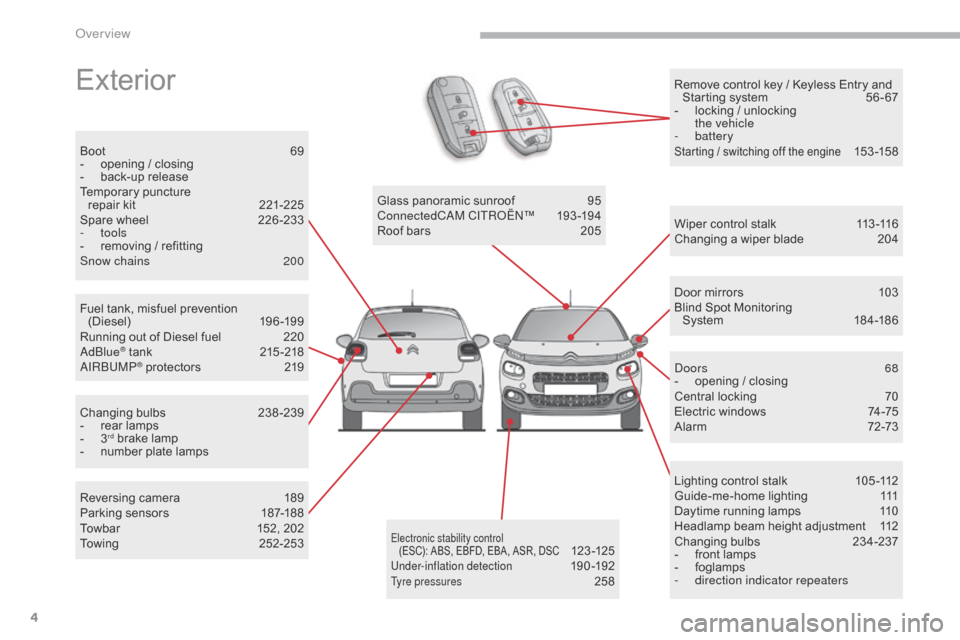
4
B618_en_Chap00b_vue-ensemble_ _ed01-2016
Remove control key / Keyless Entry and Starting system 5 6 - 67
-
l
ocking / unlocking
the vehicle
-
battery
Starting / switching off the engine 153 -15 8
Exterior
Fuel tank, misfuel prevention (Diesel) 19 6 -19 9
Running out of Diesel fuel
2
20
AdBlue
® tank 21 5 -218
AIRBUMP® protectors 2 19
Boot
6
9
-
o
pening / closing
-
b
ack-up release
Temporary puncture
repair kit
2
21-225
Spare wheel
2
26-233
-
tools
-
r
emoving / refitting
Snow chains
2
00
Changing bulbs
2
38-239
-
r
ear lamps
-
3rd brake lamp
-
n
umber plate lamps Glass panoramic sunroof
9
5
ConnectedCAM C ITROËN
™ 19
3 -19 4
Roof bars
2
05
Wiper control stalk
1
13 -116
Changing a wiper blade
2
04
Door mirrors
1
03
Blind Spot Monitoring System
18
4 -18 6
Doors 68
-
o
pening / closing
Central locking
7
0
Electric windows
7
4-75
Alarm 7 2-73
Lighting control stalk
1
05 -112
Guide-me-home lighting
1
11
Daytime running lamps
1
10
Headlamp beam height adjustment
1
12
Changing bulbs
2
34-237
-
f
ront lamps
-
fo
glamps
-
d
irection indicator repeaters
Electronic stability control (ESC): ABS, EBFD, EBA, ASR, DSC 123 -125Under-inflation detection 19 0 -192Tyre pressures 25 8
Reversing camera
1
89
Parking sensors
1
87-188
Towbar
1
52, 202
Towing
2
52-253
Over view
Page 9 of 450
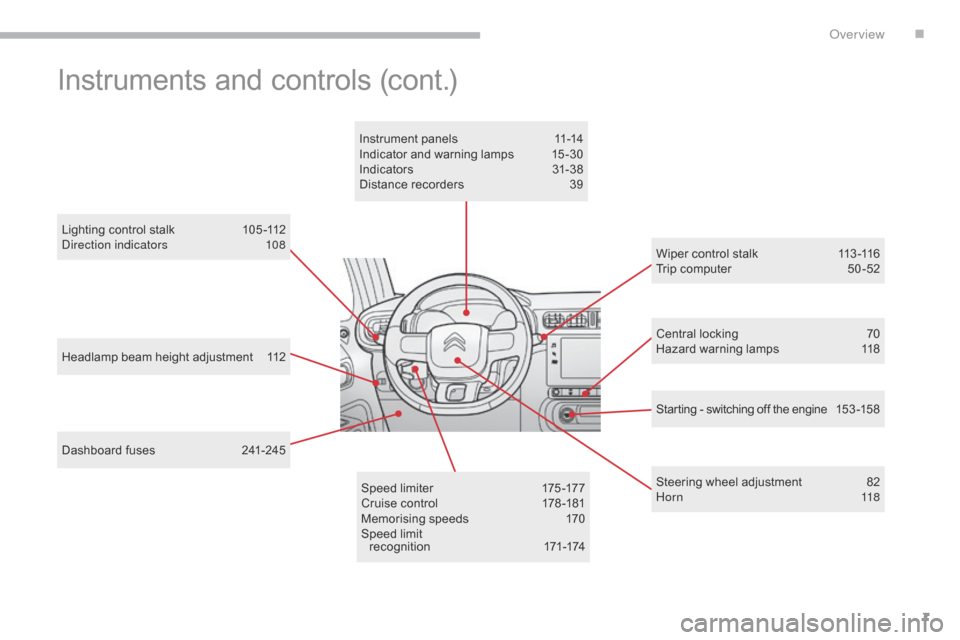
7
B618_en_Chap00b_vue-ensemble_ _ed01-2016
Headlamp beam height adjustment 112
Lighting control stalk
1
05 -112
Direction indicators
1
08
Dashboard fuses
2
41-245 Central locking
7
0
Hazard warning lamps 1 18
Wiper control stalk
1
13 -116
Trip computer
5
0 -52
Speed limiter
1
75 -177
Cruise control
1
78 -181
Memorising speeds
1
70
Speed limit r e c o g n i t i o n
17
1-174
Instrument panels
1
1-14
Indicator and warning lamps
1
5 -30
Indicators
3
1-38
Distance recorders
3
9
Steering wheel adjustment
8
2
H o r n
118
Instruments and controls (cont.)
Starting - switching off the engine 15 3 -15 8
.
Over view
Page 10 of 450
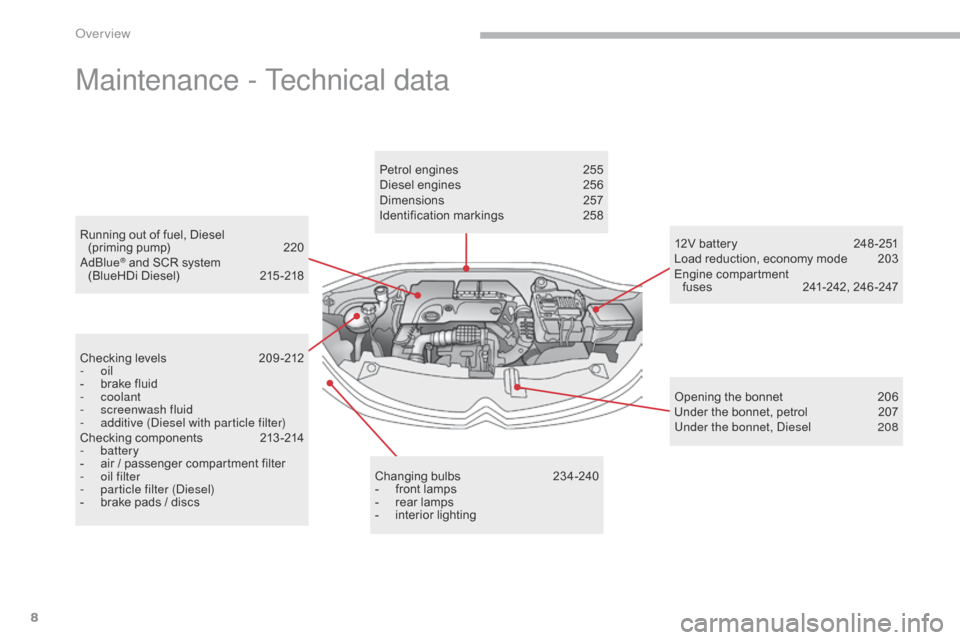
8
B618_en_Chap00b_vue-ensemble_ _ed01-2016
Running out of fuel, Diesel (priming pump) 2 20
AdBlue
® and SCR system
(BlueHDi Diesel) 2 15 -218
Maintenance - Technical data
Checking levels 2 09 -212
- oil
-
b
rake fluid
-
coolant
-
s
creenwash fluid
-
a
dditive (Diesel with particle filter)
Checking components
2
13 -214
-
battery
-
a
ir / passenger compartment filter
-
o
il filter
-
p
article filter (Diesel)
-
b
rake pads / discs Changing bulbs
2
34-240
-
f
ront lamps
-
r
ear lamps
-
i
nterior lighting
Petrol engines
2
55
Diesel engines
2
56
Dimensions
2
57
Identification markings
2
58
Opening the bonnet
2
06
Under the bonnet, petrol
2
07
Under the bonnet, Diesel
2
08
12V battery
2
48 -251
Load reduction, economy mode
2
03
Engine compartment
fuses
24
1-242, 246 -247
Over view
Page 11 of 450
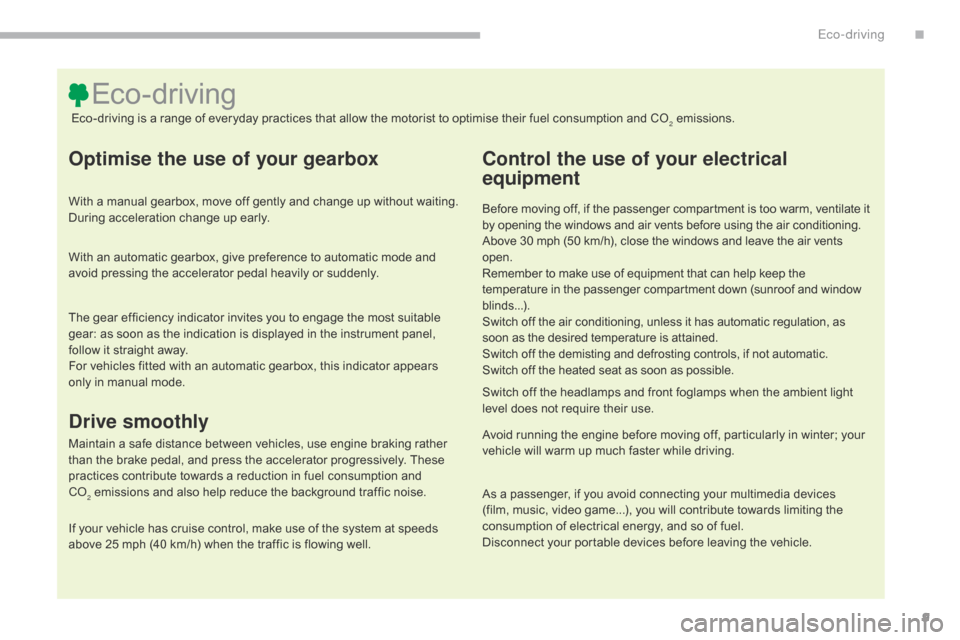
9
B618_en_Chap00c_eco-conduite_ed01-2016
Optimise the use of your gearbox
With a manual gearbox, move off gently and change up without waiting.
During acceleration change up early.
If your vehicle has cruise control, make use of the system at speeds
above 25 mph (40 km/h) when the traffic is flowing well.
Control the use of your electrical
equipment
Before moving off, if the passenger compartment is too warm, ventilate it
by opening the windows and air vents before using the air conditioning.
Above 30 mph (50 km/h), close the windows and leave the air vents
open.
Remember to make use of equipment that can help keep the
temperature in the passenger compartment down (sunroof and window
blinds...).
Switch off the air conditioning, unless it has automatic regulation, as
soon as the desired temperature is attained.
Switch off the demisting and defrosting controls, if not automatic.
Switch off the heated seat as soon as possible.
Switch off the headlamps and front foglamps when the ambient light
level does not require their use.
Avoid running the engine before moving off, particularly in winter; your
vehicle will warm up much faster while driving.
Eco-driving
Eco-driving is a range of everyday practices that allow the motorist to optimise their fuel consumption and CO2 emissions.
With an automatic gearbox, give preference to automatic mode and
avoid pressing the accelerator pedal heavily or suddenly.
The gear efficiency indicator invites you to engage the most suitable
gear: as soon as the indication is displayed in the instrument panel,
follow it straight away.
For vehicles fitted with an automatic gearbox, this indicator appears
only in manual mode.
Drive smoothly
Maintain a safe distance between vehicles, use engine braking rather
than the brake pedal, and press the accelerator progressively. These
practices contribute towards a reduction in fuel consumption and
CO
2 emissions and also help reduce the background traffic noise. A s a passenger, if you avoid connecting your multimedia devices
(film, music, video game...), you will contribute towards limiting the
consumption of electrical energy, and so of fuel.
Disconnect your portable devices before leaving the vehicle.
.
Eco-driving
Page 12 of 450
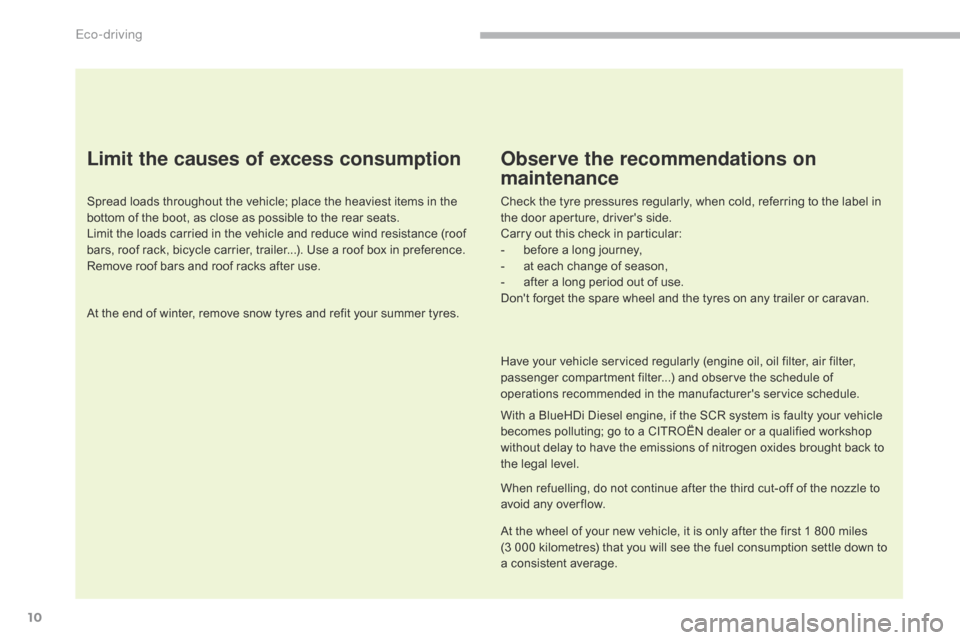
10
B618_en_Chap00c_eco-conduite_ed01-2016
Limit the causes of excess consumption
Spread loads throughout the vehicle; place the heaviest items in the
bottom of the boot, as close as possible to the rear seats.
Limit the loads carried in the vehicle and reduce wind resistance (roof
bars, roof rack, bicycle carrier, trailer...). Use a roof box in preference.
Remove roof bars and roof racks after use.
At the end of winter, remove snow tyres and refit your summer tyres.
Observe the recommendations on
maintenance
Check the tyre pressures regularly, when cold, referring to the label in
the door aperture, driver's side.
Carry out this check in particular:
-
b
efore a long journey,
-
a
t each change of season,
-
a
fter a long period out of use.
Don't forget the spare wheel and the tyres on any trailer or caravan.
Have your vehicle serviced regularly (engine oil, oil filter, air filter,
passenger compartment filter...) and observe the schedule of
operations recommended in the manufacturer's service schedule.
With a BlueHDi Diesel engine, if the SCR system is faulty your vehicle
becomes polluting; go to a CITROËN dealer or a qualified workshop
without delay to have the emissions of nitrogen oxides brought back to
the legal level.
When refuelling, do not continue after the third cut-off of the nozzle to
avoid any over flow.
At the wheel of your new vehicle, it is only after the first 1 800 miles
(3
000 kilometres) that you will see the fuel consumption settle down to
a consistent average.
Eco-driving
Page 14 of 450
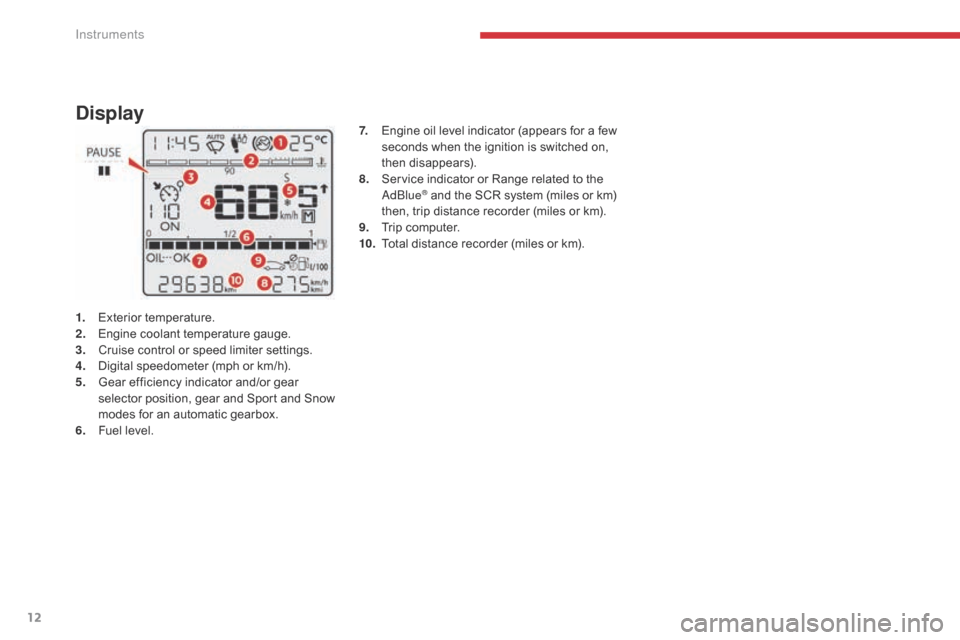
12
1. Exterior temperature.
2. Engine coolant temperature gauge.
3.
C
ruise control or speed limiter settings.
4.
D
igital speedometer (mph or km/h).
5.
G
ear efficiency indicator and/or gear
selector position, gear and Sport and Snow
modes for an automatic gearbox.
6.
F
uel level.
Display7. Engine oil level indicator (appears for a few seconds when the ignition is switched on,
then disappears).
8.
S
ervice indicator or Range related to the
AdBlue
® and the SCR system (miles or km)
then, trip distance recorder (miles or km).
9.
T
rip computer.
10.
T
otal distance recorder (miles or km).
Instruments
Page 17 of 450
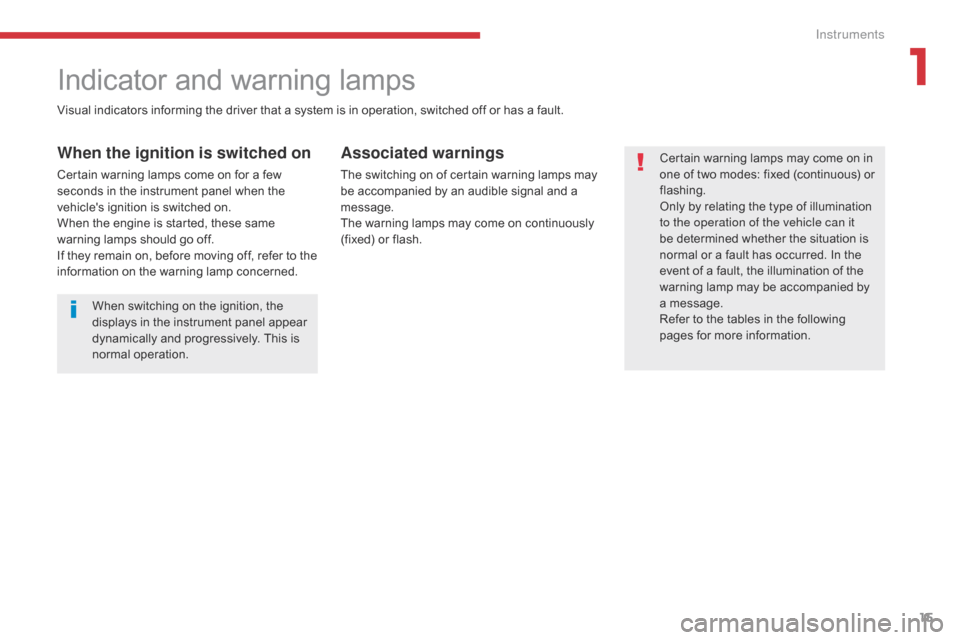
15
B618_en_Chap01_Instruments-de-bord_ed01-2016
Visual indicators informing the driver that a system is in operation, switched off or has a fault.
Indicator and warning lamps
When the ignition is switched on
Certain warning lamps come on for a few
seconds in the instrument panel when the
vehicle's ignition is switched on.
When the engine is started, these same
warning lamps should go off.
If they remain on, before moving off, refer to the
information on the warning lamp concerned.
Associated warnings
The switching on of certain warning lamps may
be accompanied by an audible signal and a
message.
The warning lamps may come on continuously
(fixed) or flash.Certain warning lamps may come on in
one of two modes: fixed (continuous) or
flashing.
Only by relating the type of illumination
to the operation of the vehicle can it
be determined whether the situation is
normal or a fault has occurred. In the
event of a fault, the illumination of the
warning lamp may be accompanied by
a message.
Refer to the tables in the following
pages for more information.
When switching on the ignition, the
displays in the instrument panel appear
dynamically and progressively. This is
normal operation.
1
Instruments
Page 19 of 450

17
B618_en_Chap01_Instruments-de-bord_ed01-2016
Rear foglampfixed. The rear foglamp has been switched
on using the ring on the lighting
control stalk. Turn the ring on the lighting control stalk to the rear to
switch off the rear foglamp.
Diesel engine
pre-heating fixed.
When the ignition is switched on
with a key in the ignition switch or a
starting instruction made using the
"START/STOP " button, the engine
temperature makes engine pre-
heating necessary. The period of illumination of the indicator lamp is
determined by the ambient conditions (up to about
thirty seconds in severe winter conditions).
With an ignition switch and key, wait until the indicator
lamp goes off before starting.
With Keyless Entry and Starting, once it goes off,
starting is immediate, on condition that the brake
pedal remains pressed with an automatic gearbox, or
the clutch pedal is pressed fully down with a manual
gearbox.
If the engine does not start, switch the ignition off and
then on, wait until the indicator lamp goes off again,
then start the engine.
Parking brake fixed. The parking brake is applied or not
properly released. Release the parking brake to switch off the warning
lamp, keeping your foot on the brake pedal.
Observe the safety recommendations.
For more information on the Parking brake
, refer to
the corresponding section.
Warning / indicator lamp
StateCause Action / Observations
Front foglamps fixed. The front foglamps are switched on
using the ring on the lighting control
stalk. Turn the ring on the lighting control stalk rear ward
twice to switch off the front foglamps.
1
Instruments
Page 20 of 450
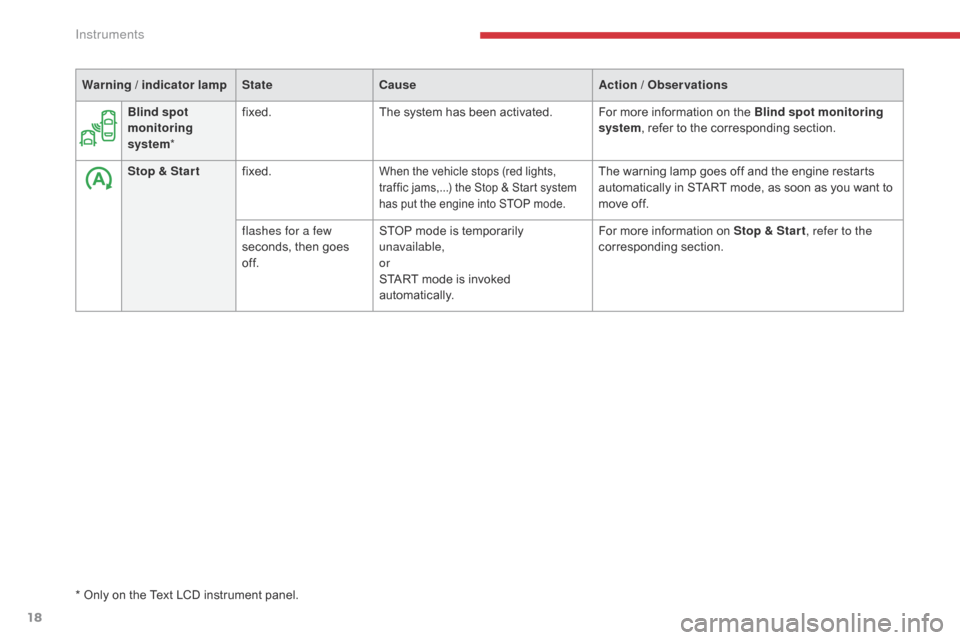
18
Warning / indicator lampStateCause Action / Observations
Stop & Star t fixed.
When the vehicle stops (red lights,
traffic jams,...) the Stop & Start system
has put the engine into STOP mode.The warning lamp goes off and the engine restarts
automatically in START mode, as soon as you want to
move off.
flashes for a few
seconds, then goes
of f. STOP mode is temporarily
unavailable,
or
START mode is invoked
automatically. For more information on Stop & Star t
, refer to the
corresponding section.
Blind spot
monitoring
system
* fixed.
The system has been activated. For more information on the Blind spot monitoring
system, refer to the corresponding section.
*
Only on the Text LCD instrument panel.
Instruments